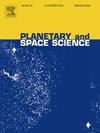利用JUICE的天基天文测量法约束木卫一的星历和内部结构
IF 1.7
4区 物理与天体物理
Q3 ASTRONOMY & ASTROPHYSICS
引用次数: 0
摘要
伽利略卫星是太阳系内最有希望成为潜在地外栖息地的候选卫星之一,即将进行的 JUICE 和 Europa Clipper 任务将对其进行广泛研究。这两个航天器都将提供无线电科学跟踪数据,这将使卫星星历的确定比目前更加精确。然而,由于没有飞越木卫二,这些数据集将偏向于三颗外围卫星。为了量化 JUICE 天体测量的贡献,我们对 JUICE 的模拟光学天体测量观测数据进行了反演,使用适当的先验协方差来代表仅用于无线电科学的解决方案。将天体测量纳入星历表求解需要考虑木卫二的图形中心(COF,天体测量测量)和质量中心(COM,星历表求解需要)之间的偏移。我们将 COF 和 COM 之间的偏移量作为模型中的一个估计参数明确考虑在内。我们评估了光学观测对星历解的贡献,将其作为无线电科学真实与形式误差比(描述模拟无线电科学解的统计真实性)以及光学数据数量和规划的函数。由此,我们讨论了天基天体测量在多大程度上可以帮助验证无线电科学解决方案,以及在哪些条件下这些数据可以改进木卫二的轨道解决方案。这表明天基光学天体测量法可以改进和/或验证无线电科学解决方案。根据观测数据的数量,使用合适的算法来选择模拟观测的时间,COF-COM 偏移的不确定性可降低约 20%到 50%。我们的结果表明,根据观测的数量和规划,可以从 100 米到 1 公里的天体测量中获得木卫二 COM-COF 偏移的约束条件。这可以提供一个新的数据点来约束木卫二的内部。此外,天体测量数据将对木卫一的轨道解决方案进行独立验证,并可能加以改进。本文章由计算机程序翻译,如有差异,请以英文原文为准。
Constraining the ephemeris and interior structure of Io using space-based astrometry by JUICE
Being among the most promising candidates for potential extraterrestrial habitats within our Solar System, the Galilean satellites are going to be extensively studied by the upcoming JUICE and Europa Clipper missions. Both spacecraft will provide radio science tracking data, which will allow the satellites ephemerides to be determined to much greater accuracy than is currently the case. Yet, with no flybys of Io, these data sets will be skewed towards the three outer satellites. To mitigate this imbalance, optical space-based astrometry from JUICE will provide a valuable contribution.
To quantify the contribution of JUICE astrometry, we have performed the inversion of simulated optical astrometric observations by JUICE, using suitable a priori covariance to represent the radio science-only solution. Incorporating the astrometry into the ephemeris solution requires the consideration of the offset between Io’s centre-of-figure (COF, which astrometry measures) and the centre-of-mass (COM, which the ephemeris solution requires). We explicitly account for the offset between COF and COM as an estimated parameter in our model.
We assess the contribution of the optical observations to the ephemeris solution as a function of the radio science true-to-formal-error ratio (describing the statistical realism of the simulated radio science solution), as well as optical data quantity and planning. From this, we discuss to which extent space-based astrometry could help to validate the radio science solution, and under which conditions the data could improve the orbital solution of Io.
Significant contributions of astrometry to Io’s orbital solution occur for radio science true-to-formal-error ratios of 4 and higher (for the along-track and normal direction). This shows that optical space-based astrometry can improve and/or validate the radio science solution. Reductions in the obtainable uncertainties for the COF-COM-offset range from about 20 to 50 per cent – depending on the number of observations – using suitable algorithms to select the epochs at which observations are to be simulated. In particular, observations during the high-inclination phase have proven especially beneficial.
Our results show that constraints on the COM-COF offset of Io could be obtained from astrometry at the level 100 m – 1 km, depending on the quantity and planning of the observations. This could provide a novel data point to constrain Io’s interior. Moreover, the astrometric data will provide independent validation – and possibly improvement – of the orbital solution of Io.
求助全文
通过发布文献求助,成功后即可免费获取论文全文。
去求助
来源期刊

Planetary and Space Science
地学天文-天文与天体物理
CiteScore
5.40
自引率
4.20%
发文量
126
审稿时长
15 weeks
期刊介绍:
Planetary and Space Science publishes original articles as well as short communications (letters). Ground-based and space-borne instrumentation and laboratory simulation of solar system processes are included. The following fields of planetary and solar system research are covered:
• Celestial mechanics, including dynamical evolution of the solar system, gravitational captures and resonances, relativistic effects, tracking and dynamics
• Cosmochemistry and origin, including all aspects of the formation and initial physical and chemical evolution of the solar system
• Terrestrial planets and satellites, including the physics of the interiors, geology and morphology of the surfaces, tectonics, mineralogy and dating
• Outer planets and satellites, including formation and evolution, remote sensing at all wavelengths and in situ measurements
• Planetary atmospheres, including formation and evolution, circulation and meteorology, boundary layers, remote sensing and laboratory simulation
• Planetary magnetospheres and ionospheres, including origin of magnetic fields, magnetospheric plasma and radiation belts, and their interaction with the sun, the solar wind and satellites
• Small bodies, dust and rings, including asteroids, comets and zodiacal light and their interaction with the solar radiation and the solar wind
• Exobiology, including origin of life, detection of planetary ecosystems and pre-biological phenomena in the solar system and laboratory simulations
• Extrasolar systems, including the detection and/or the detectability of exoplanets and planetary systems, their formation and evolution, the physical and chemical properties of the exoplanets
• History of planetary and space research
 求助内容:
求助内容: 应助结果提醒方式:
应助结果提醒方式:


